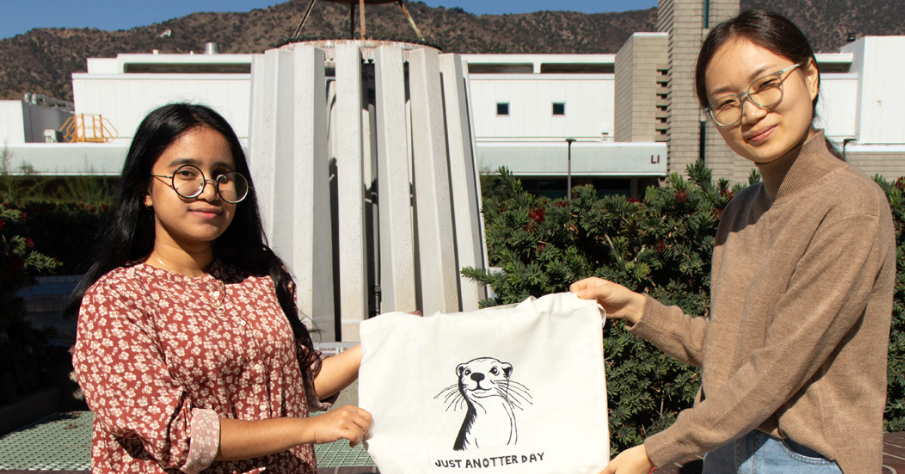Tech Support: Assistive technology helps Elina Hughes communicate with the world
Elina Hughes waits patiently in her lever drive Wijit wheelchair as people move freely in and out of the conference room to use the microwave. The 20-year-old communications major is accompanied by her personal care aide Maria Vazquez. Although she has her laptop and iPad to assist in communicating, she always makes an effort to say hello.
Unlike the other students who would solely use their voice to communicate, Hughes turns to technology. In addition to using her laptop to write, draw and speak, she also operates an iPad to compose complex sentences, gestured sign language and has her aide Vazquez to help translate.
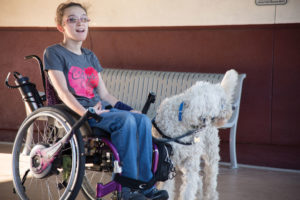
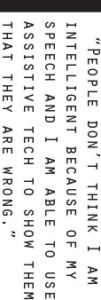 Hughes was born with athetoid cerebral palsy, a neuromotor disorder caused by damage to the developing brain. This type of CP causes abnormal, involuntary movement. Hughes does not have control over her limbs, which makes everyday functions like walking and eating difficult. CP can cause stiff muscles, spasmodic movements and speech impairment. Such a disability might cause a person to doubt their ability to navigate life, but for Hughes, this disability is a obstacle, but hardly a showstopper.
Hughes was born with athetoid cerebral palsy, a neuromotor disorder caused by damage to the developing brain. This type of CP causes abnormal, involuntary movement. Hughes does not have control over her limbs, which makes everyday functions like walking and eating difficult. CP can cause stiff muscles, spasmodic movements and speech impairment. Such a disability might cause a person to doubt their ability to navigate life, but for Hughes, this disability is a obstacle, but hardly a showstopper.
At the age of 3, Hughes was enrolled in the Conductive Education Program in Claremont, which helps children with neuromotor disabilities develop skills to function in society. She remembers feeling frustrated because she was unable to move like other kids. After countless therapy sessions and assistance through Conductive Education, Hughes quickly learned how to independently sit on a stool without back support, how to walk with a ladder device on wooden ski-type slats and how to crawl on all-fours.
Hughes wrote some of her responses on WRISE, a text-to-talk app on her laptop. “I experienced my disability as a part of life that was as natural as it could be,” she said. “I get asked a lot if I got tired of all the different kinds of therapy that I was involved with, but I wouldn’t have met some of my best friends, outstanding teachers, and awesome assistive technology developers if it weren’t for all my various disability activities.”
In the second grade Hughes attended Danbury School in the Claremont Unified School District where she was introduced to assistive technology. Her teacher, Mrs. Ginny McKee had taught special education in California for 37 years. McKee worked with many Department of Education ‘exceptionality groups’ in the Pasadena School District before teaching special education in the Claremont Unified School District for nine years before she would retire. She started at the district as a program specialist involved with the tech committee. She then started helping students with disabilities use assistive technology.
McKee said that the second grade class she co-taught was “an absolutely beautiful blending of education [involving] motor education, life skills education as well as academics.” Borbala Goda is the program Conductor– a specialized teacher who keeps students engaged in movement and exercises. The students were instructed to park their wheelchairs by the door and utilize special furniture to help with balance and movement in order to maintain their well-being. McKee taught the curriculum and introduced students to various low-tech and high-tech devices to foster independence.
McKee noted that much of the technology had not yet been as developed as they should have been and that the class was more about physically supportive activities through Conductive Education. It wasn’t until the fourth grade that Hughes would become a “techie”, and her journey with assistive technology would get underway.
With help from Ginny McKee, Elina would meet David Niemeijer, CEO and founder of AssistiveWare. McKee would first meet Niemeijer at a conference at California State University Northridge Assistive Technology Conference. She knew that the software at AssistiveWare would benefit Elina and the other students and so she adapted the tech into her curriculum. A couple months later Niemeijer would reach out to Elina to to observe her development and learning process.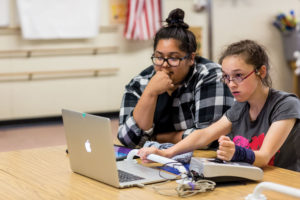
Niemeijer met with Elina and her family in 2007 to film Elina’s computer demonstration and progress through assistive technology. Elina and Niemeijer have developed a strong relationship since and he has seen a significant growth in her development through assistive technology.
“When I started AssistiveWare it was my dream to create products that would help people with physical, vision or speech impairments to achieve their full potential and be limited only by their talent and motivation,” Niemeijer said. “To me, Elina is one of the many people I have come to meet over the years who lives that dream!”
Elina would go on to try other gadgets like touch screens, trackballs and a head mouse, a device that tracks a person’s head movements and translates it to a computer mouse movement. It took about a year before Hughes would finally find a system that worked easily for her.
“That system turned out to be a Mac laptop, using AssistiveWare’s Keystrokes and Proloquo with a slow speed joystick and a switch,” said Hughes. “It all fell into place and I could finally write, speak, and even draw independently.”
KeyStrokes is an on-screen keyboard while Proloquo is an Alternative and Augmentative Communication tool, known as AAC. Proloquo provides a voice for people who may have a difficult time speaking or for those who cannot speak.
While Hughes was demonstrating her typing skills on her laptop her aide Vazquez said that the joystick and switch is essentially a device that acts as a mouse. The joystick moves the computer cursor while the switch is like the clicker on a mouse.
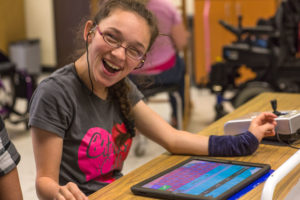 Elina Hughes is now in her second year at Citrus College and has a schedule like any other college student. At 8 a.m., the Hughes household is still half-asleep as Elina is awakened by the warm, wet kisses of Zoe, her Canine Angels Service Dog. With help from her family and Maria, she gets dressed, gets her school things packed, grabs a bite to eat and heads to school with Vazquez. Means of transportation varies whether it be by Access van, The Metro Gold Line or by car. Elina is excelling in all of her course, going above and beyond what is required and always getting ahead in her courses.
Elina Hughes is now in her second year at Citrus College and has a schedule like any other college student. At 8 a.m., the Hughes household is still half-asleep as Elina is awakened by the warm, wet kisses of Zoe, her Canine Angels Service Dog. With help from her family and Maria, she gets dressed, gets her school things packed, grabs a bite to eat and heads to school with Vazquez. Means of transportation varies whether it be by Access van, The Metro Gold Line or by car. Elina is excelling in all of her course, going above and beyond what is required and always getting ahead in her courses.
“Elina is possibly one of the most hard working individuals I know,” said Vazquez. “She is full of life and makes everyday a new and educational one for anyone that knows her.”
Elina continues with her Conductive Education Tuesdays and Thursdays at Danbury School in Claremont. The rigorous two-hour course pushes for socio-cultural integration of children with motor disorders by assisting the individual to develop problem solving skills in daily living. When she isn’t studying, doing homework or doing Conductive Education she enjoys painting in ArtRage, a computer program that simulates natural art, swimming at her grandparents house and playing pranks on her friends and family.
Karla Hughes recalls a time when Elina bought some Roach-O-Ramas. A gag toy that included a pack of fake cockroaches that moved and looked like the insect. While Elina was out camping she had her assistant put the roaches in some of the boys sleeping bags. Elina had just gotten back from the camping trip. Karla Hughes remembers the moment vividly. “When I was cleaning out her backpack, I freaked out!” Little did she know Elina kept the roaches in her backpack for safe keeping.
Although Conductive Education has helped Hughes maintain her mobility and confidence, the use of assistive technology has helped revolutionize her life. Elina plans on getting into public relations and helping others develop with assistive technology.
Whether it be written in a text document on a computer or announced by the text-to-talk feature from Proloquo2Go, her words are spoken with confidence and praise to the opportunities given to her with assistive technology.
“In all aspects, A.T. has changed my life,” Hughes said. “People don’t think I am intelligent because of my speech and I am able to use assistive tech to show them that they are wrong.”


